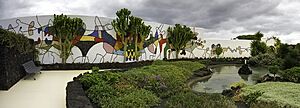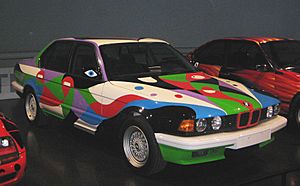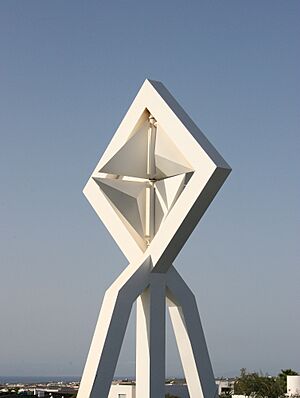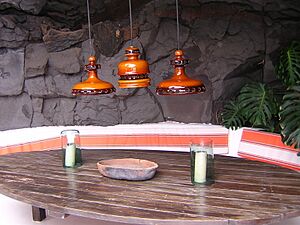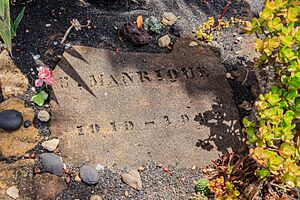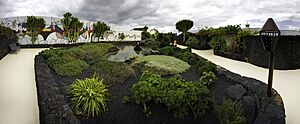César Manrique facts for kids
Quick facts for kids
César Manrique
|
|
|---|---|
| Born | 24 April 1919 Arrecife |
| Died | 25 September 1992 Tahíche |
| Alma mater |
|
| Occupation | Painter, architect, sculptor |
| Awards | |
| Signature | |
 |
|
César Manrique Cabrera (born April 24, 1919 – died September 25, 1992) was a famous Spanish artist. He was a painter, sculptor, and someone who cared deeply about nature. César came from the island of Lanzarote. He is best known for his amazing building projects there, where he guided the artistic design.
Contents
Early Life and Education
César Manrique was born in Arrecife, a town on the island of Lanzarote. This island is part of the Canary Islands. His family home was built in Caleta de Famara. César often said that this house and the area around it greatly inspired him.
He briefly studied architecture at the University of La Laguna. Later, in 1945, he moved to Madrid. There, he received a special scholarship. This allowed him to study at the Art School of San Fernando. He graduated as a teacher of art and painting.
Artistic Journey and Return to Lanzarote
From 1964 to 1966, César Manrique lived in New York City. He received a grant from Nelson Rockefeller. This helped him rent his own art studio. During his time in New York, he created many paintings. These artworks were shown in a well-known gallery called "Catherine Viviano."
In 1966, Manrique decided to return to Lanzarote. He had a big dream: to create an artist's community on the island. His childhood friend, Pepín Ramírez, who was the island's president, helped him make this dream come true.
Protecting Lanzarote's Beauty
César Manrique used the unique landscape and colors of Lanzarote in his art. He also used them in the buildings he designed on the island. He was very committed to protecting Lanzarote. He wanted to stop harmful tourist developments.
Manrique was not against tourism. In fact, he believed that good quality tourism could help the island's economy. He worked hard to make sure tourism developed in a way that protected Lanzarote's natural beauty.
One of his big ideas was to ban very tall hotels. He felt these "high-rise" buildings did not fit the island's natural look. Buildings built before this ban usually use traditional colors. Homeowners are also encouraged to keep their houses white. This helps keep the island looking unified and beautiful.
César Manrique's Famous Works
César Manrique left behind many incredible projects on Lanzarote. These places are now popular art, culture, and tourism centers.
- Jameos del Agua (1963–87): A unique space built inside a volcanic cave.
- His Volcano House, Taro de Tahiche (1968): This was his home, built into volcanic bubbles.
- The restaurant at the restored Castillo de San José in Arrecife (1976).
- The visitors center at the Timanfaya National Park (1971).
- His Palm Grove House in Haria (1986).
- The Mirador del Rio (1973): A viewpoint built into a cliff.
- The Jardín de Cactus in Guatiza: A garden with over 1,100 types of cacti.
In 1974, Manrique also published a book. It was called Architecture Unpublished. He worked on it with a famous Spanish architect, Fernando Higueras.
International Recognition
César Manrique became famous not just in the Canary Islands, but around the world. In 1990, he worked on a special project. He created one of the well-known BMW Art Cars. He collaborated with a German designer named Walter Maurer.
This partnership with the international car company made Manrique even more famous. He and Walter Maurer remained close friends until Manrique's death in 1992. They often shared artistic ideas.
Before working with Manrique, Maurer had designed BMW Art Cars with other famous artists. These included Andy Warhol, Frank Stella, and Roy Lichtenstein. The work for their joint Art Car happened in Maurer's studio in Munich. Manrique created the first designs. He then worked with Maurer to finalize them. Maurer was responsible for putting the design onto the BMW 730i car.
In September 2019, 100 years after his birth, Manrique received a special award. It was the Medal of Honor from the University of La Laguna. This was the same university where he had studied architecture briefly.
César Manrique Foundation
The César Manrique Foundation was started in 1982. César Manrique and some friends created it. However, it officially opened after Manrique passed away in 1992.
The foundation is located in Manrique's former home. It is a private, non-profit organization. Its main goal is to let visitors explore Manrique's unique house. The foundation also has an art gallery. It shows art created by Manrique himself. It also displays art he collected during his life. This includes original drawings by famous artists like Pablo Picasso and Joan Miró.
The money from ticket sales helps promote art from Lanzarote. It also funds the foundation's "artistic, cultural, and environmental activities."
Manrique's Unique Home
Manrique's home is built on a 3,000 square meter plot of land. This land was part of the Lanzarote volcanic eruptions in the 1700s. He created this house after returning from New York City in 1966.
The rooms on the first floor were designed to mix Lanzarote traditions with modern ideas. They have open spaces and large windows. The "basement" level is even more special. It has five rooms built inside natural volcanic bubbles. These rooms were carved into the volcanic rock. There is also a central cave. This cave has a fun area with a swimming pool, a barbecue, and a small dance floor.
Outside the main house, there is a small square with a fountain. Nearby, you can find a small café and a gift shop. This area used to be César Manrique's garage.
One of the foundation's key goals is to fight against too many tall concrete buildings. They want to protect the natural look of the Spanish coastlines and islands. The foundation recently pointed out 24 hotels in Lanzarote that were built without proper permission.
Death
César Manrique died in a car accident in Tahíche, Teguise. This was very close to the Foundation, his home in Lanzarote. He was 73 years old when he passed away in 1992.
Honors and Awards
César Manrique received many awards for his work:
- 1978: Weltpreis für Ökologie und Tourismus (World Prize for Ecology and Tourism), Berlin, Germany.
- 1986: Europa Nostra Prize from the European parliament.
- 1989: Art Prize from the Canarian government.
- 1989: Fritz Schumacher Prize at the Leibniz University Hannover, Germany.
Notable Works by César Manrique
César Manrique created many important works.
In Lanzarote
- Casa / Museo César Manrique: Manrique's house and art studio in Haria, with a beautiful garden.
- Mirador del Rio: A viewpoint built in 1973, looking over the nearby island of Graciosa.
- Jameos del Agua: A concert hall and nightclub for 600 people, located inside a cave.
- Jardín de Cactus: A garden with over 1,100 different types of cactus plants near Guatiza.
- Taro de Tahíche: Manrique's house near Teguise, now home to the Fundación César Manrique.
- International Museum of Contemporary Arts: Located in the Castillo de San José, Arrecife.
- Garden and swimming pools of the five-star hotel Las Salinas in Costa Teguise.
- El triunfador: A sculpture built in 1990 near the Fundación César Manrique.
- Juguetes del viento: A windmill sculpture built in 1992 in Arrieta.
- El Diablo: The symbol of the Timanfaya National Park.
- El Diablo Restaurant: A restaurant that uses heat from the volcano to cook food.
Outside Lanzarote
- Lago Martiánez (1977): A large "semi-natural" outdoor seawater pool complex in Puerto de la Cruz, Tenerife.
- Playa Jardín: A volcanic beach and tropical gardens in Puerto de la Cruz, Tenerife.
- La Vaguada Shopping Centre in Madrid (1983): The first shopping center in Spain that blended perfectly with its natural surroundings.
- La Peña (1989): A restaurant and viewpoint on El Hierro island.
- Mirador del Palmarejo (1989): A lookout point in La Gomera island.
- BMW Art Car (1990): Created in collaboration with Walter Maurer in Munich, Germany.
- Canarian Pavilion (1992): At Expo 92 in Seville, Spain.
- Parque Marítimo César Manrique: A park in Santa Cruz de Tenerife, Tenerife.
See also
 In Spanish: César Manrique para niños
In Spanish: César Manrique para niños
- List of single-artist museums
Images for kids
-
Wind sculpture (Las Palmas de Gran Canaria)
-
Taro Tahiche (Lanzarote)


